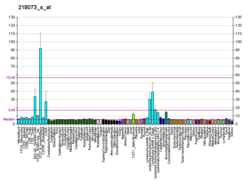| NDC1 |
|---|
|
| Identifiers |
|---|
| Aliases | NDC1, NET3, TMEM48, NDC1 transmembrane nucleoporin |
|---|
| External IDs | OMIM: 610115; MGI: 1920037; HomoloGene: 41224; GeneCards: NDC1; OMA:NDC1 - orthologs |
|---|
| Gene location (Human) |
|---|
 | | Chr. | Chromosome 1 (human)[1] |
|---|
| | Band | 1p32.3 | Start | 53,765,478 bp[1] |
|---|
| End | 53,838,463 bp[1] |
|---|
|
| Gene location (Mouse) |
|---|
 | | Chr. | Chromosome 4 (mouse)[2] |
|---|
| | Band | 4|4 C7 | Start | 107,224,981 bp[2] |
|---|
| End | 107,273,543 bp[2] |
|---|
|
| RNA expression pattern |
|---|
| Bgee | | Human | Mouse (ortholog) |
|---|
| Top expressed in | - secondary oocyte
- gonad
- ventricular zone
- tibia
- gingival epithelium
- epithelium of nasopharynx
- mucosa of colon
- mucosa of sigmoid colon
- germinal epithelium
- testicle
|
| | Top expressed in | - tail of embryo
- genital tubercle
- primitive streak
- cumulus cell
- spermatocyte
- epiblast
- maxillary prominence
- condyle
- yolk sac
- medullary collecting duct
|
| | More reference expression data |
|
|---|
| BioGPS |  | | More reference expression data |
|
|---|
|
| Gene ontology |
|---|
| Molecular function | - structural constituent of nuclear pore
| | Cellular component | - cytoplasm
- integral component of membrane
- nuclear membrane
- nuclear envelope
- membrane
- plasma membrane
- nuclear pore
- actin cytoskeleton
- nucleus
- spindle pole body
- nuclear pore transmembrane ring
- host cell
| | Biological process | - mRNA transport
- nuclear pore complex assembly
- viral transcription
- protein sumoylation
- mitotic nuclear membrane disassembly
- homologous chromosome pairing at meiosis
- spermatogenesis
- protein transport
- regulation of cellular response to heat
- viral process
- mRNA export from nucleus
- intracellular transport of virus
- tRNA export from nucleus
- spindle pole body duplication
- regulation of gene silencing by miRNA
- regulation of glycolytic process
- transport
- nuclear pore organization
| | Sources:Amigo / QuickGO |
|
| Orthologs |
|---|
| Species | Human | Mouse |
|---|
| Entrez | | |
|---|
| Ensembl | | |
|---|
| UniProt | | |
|---|
| RefSeq (mRNA) | | |
|---|
| RefSeq (protein) | | |
|---|
| Location (UCSC) | Chr 1: 53.77 – 53.84 Mb | Chr 4: 107.22 – 107.27 Mb |
|---|
| PubMed search | [3] | [4] |
|---|
|
| Wikidata |
| View/Edit Human | View/Edit Mouse |
|

















